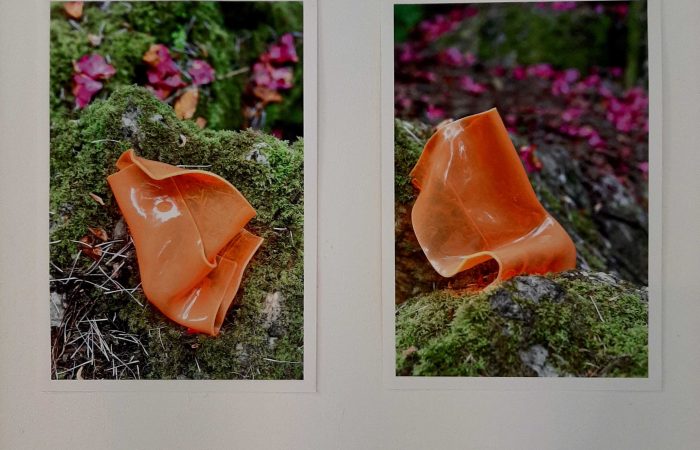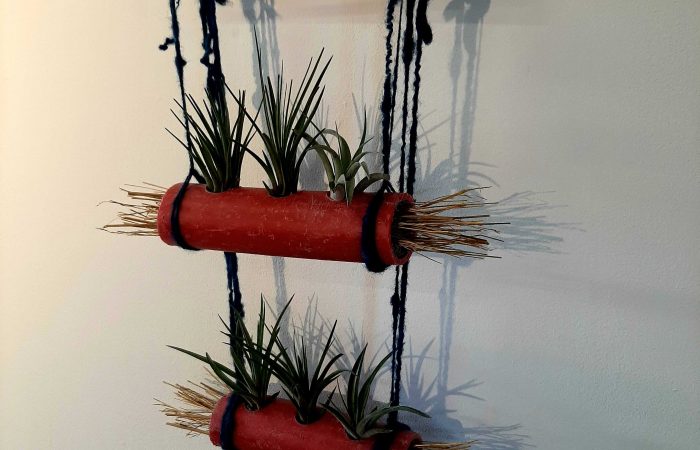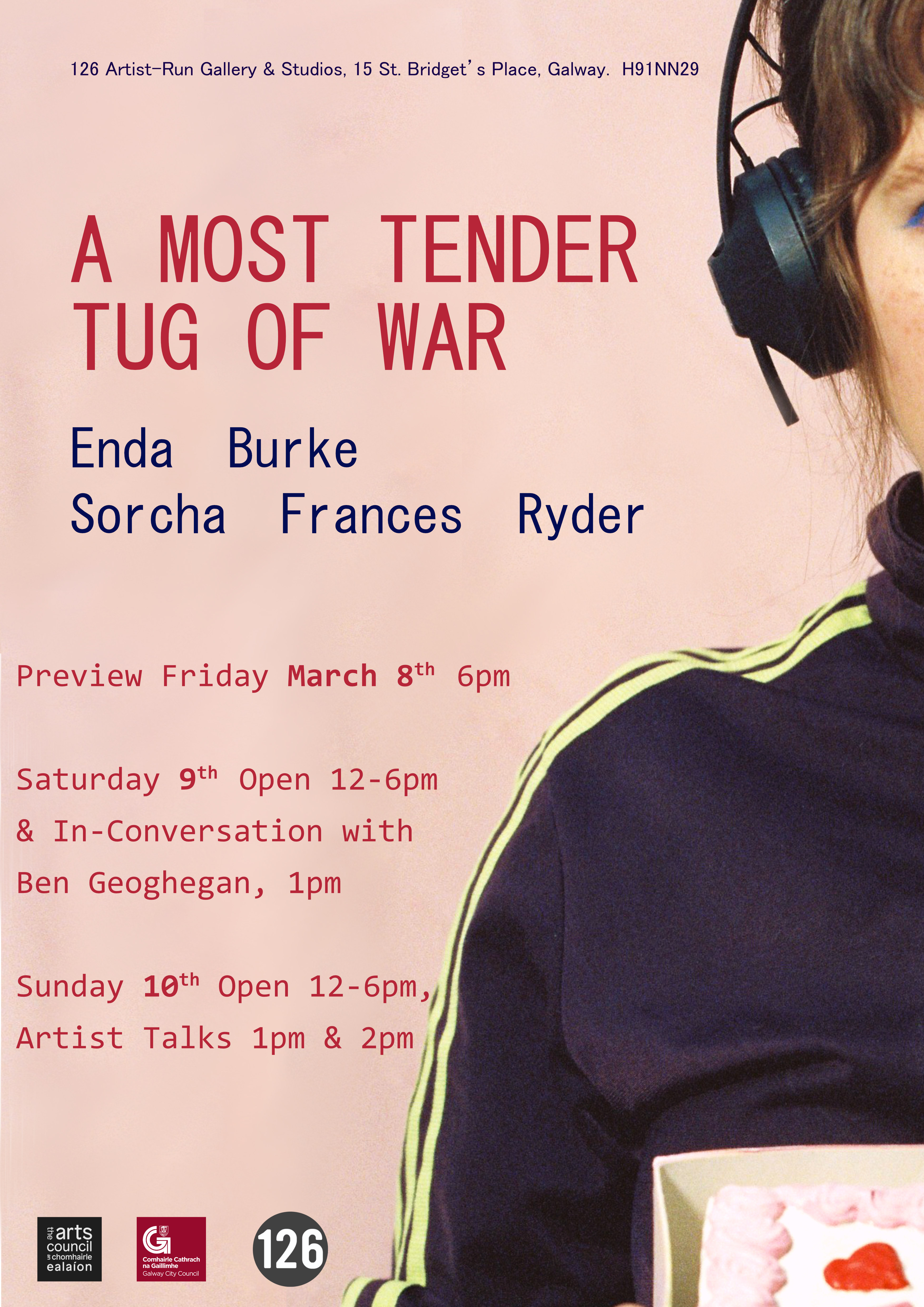Elizabeth Grace Bleynat | My studio practice is materially driven and conceptually multifaceted. Delving into ecofeminist theory, I investigate intersectional concepts of environmental degradation, global inequities, queer embodiment, and non-binary thought. My work considers human labour and eco-ethics, drawing parallels between a culture of disposability of material goods and of human labour. The material base of my art practice is found-plastic. Notions of labour – seen and unseen – are implicit and explicit within these plastic objects.
My regular coastal walks in County Clare enable me to remove large quantities of plastic from the shore. These items are my source material. I work methodically, delighting in accentuating beauty in frayed and sun bleached turquoise ropes, crumling orange rubber boots, and glittering neon fishing lures. Utilising the objects across diverse media – textile, installation, performance, photography, and film – I advocate for mending and repurposing, for living harmoniously with the planet, for restoration before exploitation, and for non-violent approaches to structural, societal change. Imbuing value back into existent plastic material through art practice suggests an alternative way of life – one resistant to the linear nature of consumerism. | Hugh Delap | We live in a time of constant tension. Despite claims of progress as a race we face war, genocide, climate breakdown, pandemics, concerns with nuclear proliferation, racism, inequality and indifference. Facing these longstanding grounds for despair we make do. We work, we seek relationships, build families, pay bills and do our best to find interests and joy, all in order to keep distance from the edge of the abyss. There is a contrast between the world we hope for and the world we expect. I make paintings in an attempt to create meaning in an otherwise indifferent, meaningless and brutal world. I do not seek to prove a point, but to evoke and share a vision. These paintings are made using the ancient traditions of natural hand ground pigment mixed with pestle and mortar. Through an alchemic process the earth pigments take on a new energy that manifest contemporary concerns and embody the performance of painting. My practice sits within ancient and contemporary approaches to painting and explores process of evoking meaning through the use of colour, pigment, sound and ambiance. | Bryan Gerard Duffy | I am a multi-disciplinary artist working in paint, sculpture, lens-based work, moving image and installation. I draw lines and also cross lines, both physically and metaphysically while investigating psychological and physical displacement. My work considers strategies of movement, restrictions, and exclusion of human beings while also exploring spaces such as “”occupied territories””, buffer zones, “non-places”, surveillances, systems, the internet and our minds through mapping and mark making. I aim to provoke anxiety; initiate confrontations; to observe secrecy. The fragility of human existence comes to the fore, and is on a collision course with its own creation, artificial intelligence (A.I.). Technology influences my work as video and photography are fundamental to my practice. I frequently reference my family’s photographic archival collection, Duffy’s Photography est. 1912. My work dissects measuring systems and algorithms, I install cctv cameras, incorporate social media platforms, as well as transcending borders using google maps. Artificial Intelligence and systems juxtapose the nomadic cultural patternings I research. I overlap traditional techniques with modern day technology, I aim to create games. Recent paintings explore the chess games between past world chess champions and supercomputers. My playful attitude to materials and situations counterbalances a very serious social conscience and political intent. | Maura Finnegan | My work investigates the unspoken dialogue of furtiveness in the human psyche and trauma in its many forms. My arts practice is sculptural assemblage. the method of communicating the effects of prolonged suffering and trauma is through materiality. Familiar domestic objects associated with the female become ’embodiments of pain & loss.’ Nylon tights, bedding, bandage, undergarments, upholstery foam are some of the materials I use. My soft/sculptural forms are exposed to an almost violent deconstructive creative process – ripping, tearing, knotting, slicing, piercing, burning etc – exposing the bruised contents.The thread of materiality undergoing this transmutational force both reveals & conceals simultaneously. | Katerina Gribkoff | My practice seeks to entangle an art-making system with complex living systems of growth and cultivation. It centres the garden in art-making, as a material source, a gallery for display, a repository for decomposing works, and a stage for plant-people-plot interplay. In my work, I seek to understand the position of materials within mesh-like webs of entanglement between human, non-human, and non-living entities, and the potential for material to foster better connections between human and more-than-human worlds. Visiting farms and gardens, I engage with maintained systems of growth to better understand the imperfect material realities of collaborating with plants. Mirroring a gardener’s use of material, I utilise the abundant, the local, the used, the discarded—what is available and what fulfils a need. I take care when speculating the needs of plant-kin, moving slowly and intentionally, making educated improvisations through acts of quilting, tucking, and stuffing. My methodology includes growing and foraging to make plant-derived dyes, inks, pigments, and stains; working with textiles including cotton, wool, and soil bags; and building structures in collaboration with plants. | Carol Healy | Carol Healy is a visual artist living in Cork City, she works with drawing and installation. Her artworks and research explore the relationship between humans and nature, with an increasing focus on human activities and their rippling effects on our planet. Working directly with nature in all forms, she pays special attention to the trees and plants in her local urban environment. A tree trunk salvaged after storm Ophelia which Healy made drawings from previously, has been re-imagined in this work to question our unnecessary and excessive use of the natural world today – at what costs? | Helen Hughes | Making and materiality are foundational in my predominantly sculptural practice which takes influence from mass produced commodities and the fetishistic surfaces of retail. Manipulating industrially manufactured elements, I probe the homogeneity prevalent in consumerist society to participate and engage with capitalist concepts and constructs differently. Honing and developing my own improvised, markedly physical processes, and utilising materials that are wilful and difficult to control (eg, balloons, fast-cast resins) my practice is rooted in the body and its ways of understanding. My intention counters increasingly virtual ways of navigating the world and a growing remove from materiality. Material elements are reworked through removal, addition and recasting to disguise or reveal appearances and to mimic each other and other things. Pushing against the nature of materials and their designed functioning, I embrace the surprise and perversity that materialises to reference the accidental/incidental occurring in manufacture. Drawing attention to latent qualities and hidden agency within materials, I view this as an expansion of the industrial process where my improvised actions result in a more human sensibility. | Breda Lynch | Breda Lynch is a visual artist working in a variety of media, including drawing, photography, print and digital media, video and installation. She engages with dialogues and discourses on – queer feminisms and hidden histories, the western mystery tradition and occulture, appropriation and the economy of the image.The cyanotype exhibited comes from a larger body of cyanotype/digital print work titled ‘Fragments of a Lost Civilisation’ that started in 2015 and is still growing in production and variety. The use of an older analogue photographic method called cyanotype, also known as blue print, has been used for its colour and reproduction properties to create ‘copies’ from foraged images from various sources, including online. The cyanotypes subsequent scanning and digital printing allows for the images to be sized up and presented in different ways. From formally presented in a gallery setting to being posted in outside settings either in the form of digital prints or vinyl installations. | Aoife Anna Mullan | Aoife Mullan (b.1990) lives and works in Dublin, Ireland. Her practice is interdisciplinary and incorporates text, sculptural objects, photography and installation. Her work explores image and object making through the display and experience of object and materials. Aoife is a recent graduate of TU Dublin (Masters in Creative Digital Media) and has a BFA (Fine Art Painting) from NCAD. | Helen O’Shea | Seeing images of plastics deep on the ocean floor, in places no person has ever been, examples the result of our consumption habits. Sea creatures have started using these plastics, with Hermit crabs using containers as new homes. Co-habitation with our waste presents the idea of re-use as one way forward. This led me to explore the deep-water hydrothermal vents; originally an environment thought to support no life but is now identified as the origin of life on earth! This idea of possibility in the face of unlikelihood inspired me to create delicate futuristic creatures from waste plastics.
“…when people recycle or compost or refuse a plastic bag because they feel that this minor gesture will make a difference, …they are enacting a different relation to waste, letting it register in the dimension of the ethical. “ Gay Hawkins The Ethics of Waste: how we relate to rubbish.” 2006. Inspired by Hawkins, the prospect of drowning in our own detritus propels me to present a different relation to waste. How can we promote a new way of being. Exhibiting pre-used plastics as desirable, disrupts its status as ‘waste’ and conjures a different relationship to the previously unwanted material. | Lorraine Walsh | In 2020 I began looking at somehow salvaging or repairing work that had been cut up, taken off stretchers and generally discarded, into something else. This work could somehow be a material record of my time spent in the studio as well as speak about making something meaningful from scraps of what had gone before. The first work I made in this vein is Archive to Sun and Rain a work collaged on found paper from scraps of failed painted paper and canvas works. I work intuitively, usually on the floor using the scraps of previous paintings, thin layers of oil paint, oil sticks and various other mark making tools. These individual pieces are then collaged together to create a larger painting. The process is intuitive and involves much chopping and changing. The aesthetic of my this work is informed by several sources including atmospheric phenomena, such as rain, sun, wind and nature, and the intuitive process of working with materials in the studio.



















